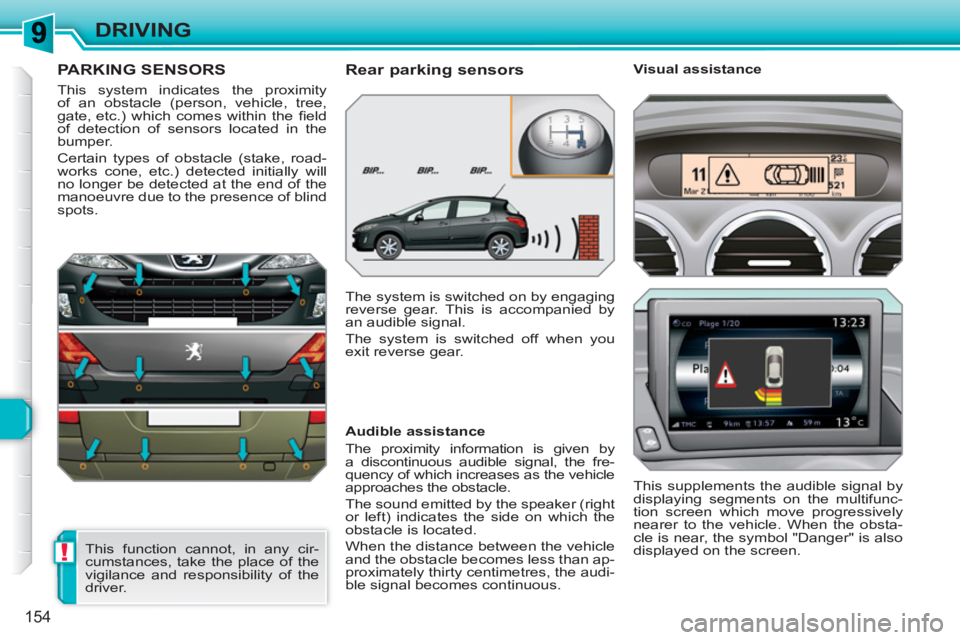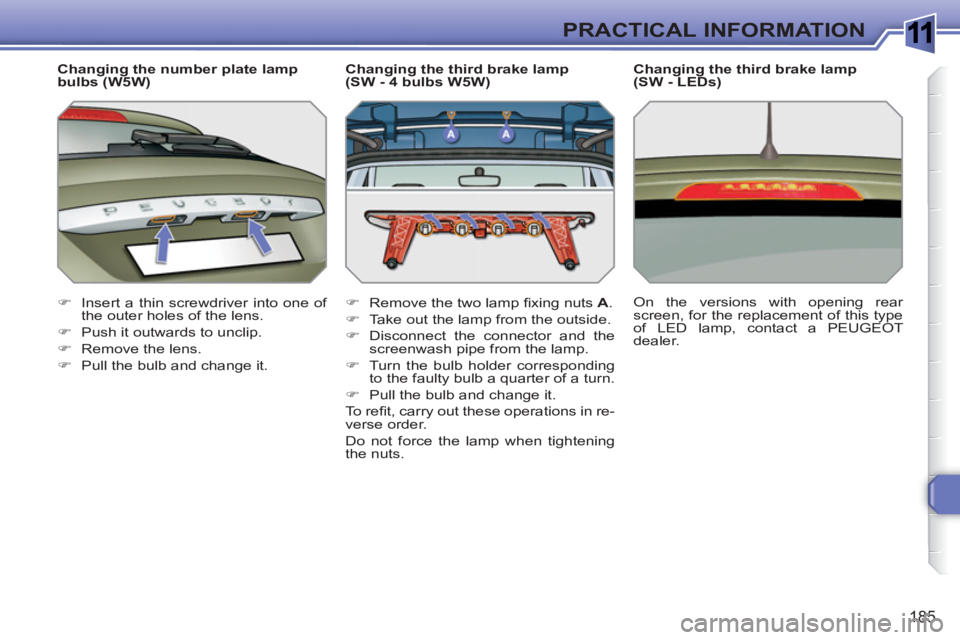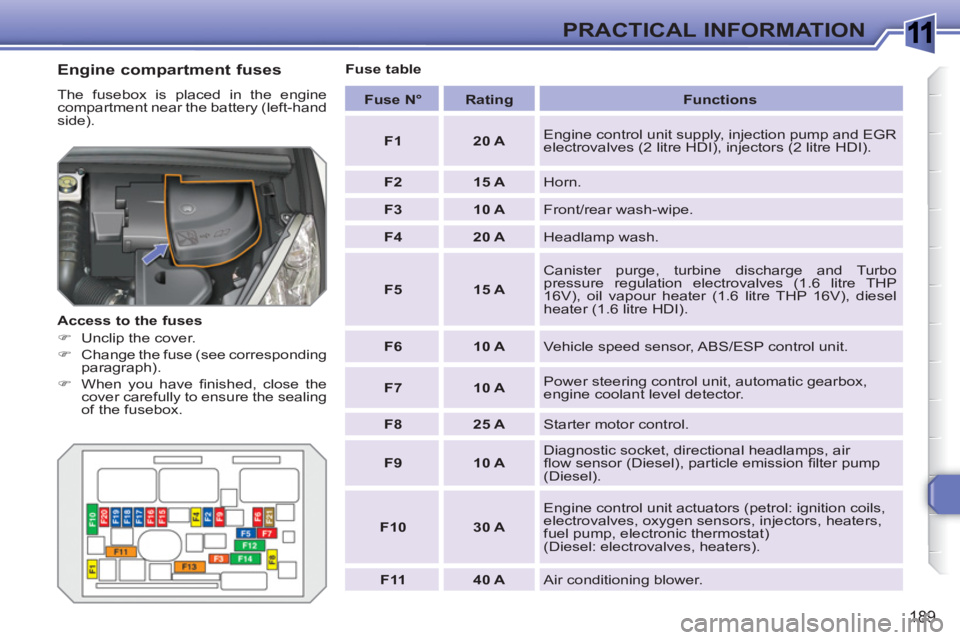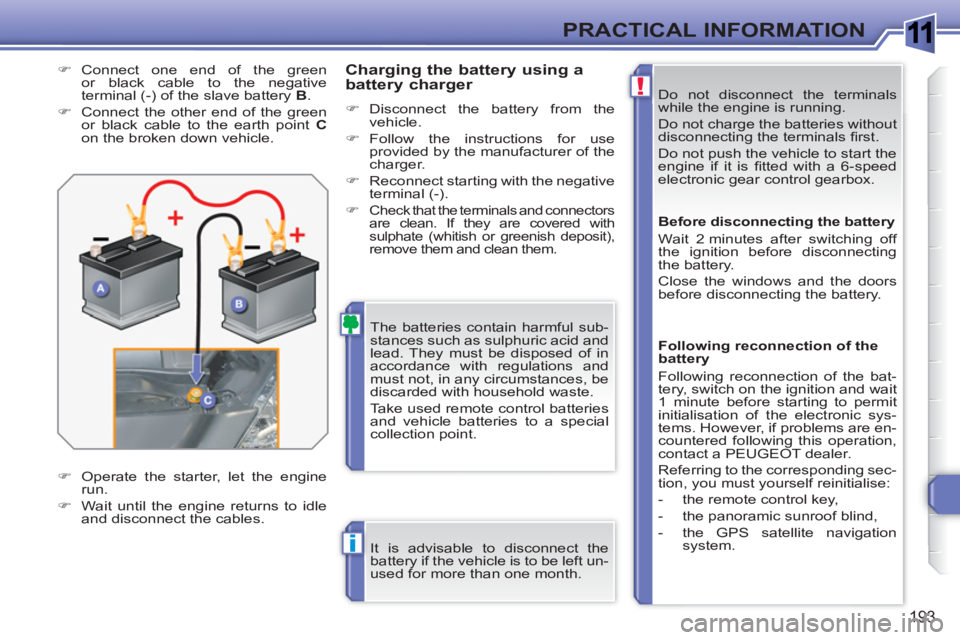2010 PEUGEOT 308 SW BL ESP
[x] Cancel search: ESPPage 154 of 336

i
152
DRIVING
CRUISE CONTROL
System which automatically maintains
the speed of the vehicle at the value
programmed by the driver, without any
action on the accelerator pedal.
The cruise control is switched on
manually: it requires a minimum vehi-
cle speed of 25 mph (40 km/h) and the
engaging:
- of fourth gear on the manual gearbox,
- of second gear on the electronic
gear control gearbox or automatic
gearbox, in sequential driving mode,
- of position A
on the electronic
gear control gearbox or D
on the
automatic gearbox. The controls of this system are grouped
together on stalk A
.
1.
Cruise control mode selection dial
2.
Speed programming/programmed
value decrease button
3.
Speed programming/programmed
value increase button
4.
Cruise control off/resume button The programmed information is grouped
together on the instrument panel dis-
play.
5.
Cruise control off/resume indication
6.
Cruise control mode selection indi-
cation
7.
Programmed speed value
Steering mounted controls
Displays on the instrument panel
The cruise control cannot, in any
circumstances, replace the need
to observe speed limits, nor can it
replace the need for vigilance and
responsibility on the part of the
driver. The cruise control is switched off
man-
ually or by pressing the brake or clutch
pedal or on triggering of the ESP sys-
tem for safety reasons.
It is possible to exceed the programmed
speed temporarily by pressing the ac-
celerator pedal.
To return to the programmed speed,
simply release the accelerator pedal.
Switching off the ignition cancels any
programmed speed value.
Page 156 of 336

!
154
DRIVING
PARKING SENSORS
This system indicates the proximity
of an obstacle (person, vehicle, tree,
gate, etc.) which comes within the fi eld
of detection of sensors located in the
bumper.
Certain types of obstacle (stake, road-
works cone, etc.) detected initially will
no longer be detected at the end of the
manoeuvre due to the presence of blind
spots.
This function cannot, in any cir-
cumstances, take the place of the
vigilance and responsibility of the
driver.
Rear parking sensors
The system is switched on by engaging
reverse gear. This is accompanied by
an audible signal.
The system is switched off when you
exit reverse gear.
Audible assistance
The proximity information is given by
a discontinuous audible signal, the fre-
quency of which increases as the vehicle
approaches the obstacle.
The sound emitted by the speaker (right
or left) indicates the side on which the
obstacle is located.
When the distance between the vehicle
and the obstacle becomes less than ap-
proximately thirty centimetres, the audi-
ble signal becomes continuous.
This supplements the audible signal by
displaying segments on the multifunc-
tion screen which move progressively
nearer to the vehicle. When the obsta-
cle is near, the symbol "Danger" is also
displayed on the screen.
Visual assistance
Page 163 of 336

10
!
161
CHECKS
CHECKING LEVELS
Check all of these levels regularly and
top them up if necessary, unless other-
wise indicated.
If a level drops signifi cantly, have the
corresponding system checked by a
PEUGEOT dealer.
Brake fluid level
In addition, as the cooling system is
pressurised, wait at least one hour after
switching off the engine before carrying
out any work.
To avoid any risk of scalding, unscrew
the cap by two turns to allow the pres-
sure to drop. When the pressure has
dropped, remove the cap and top up
the level.
Oil level
The reading will only be correct
if the vehicle is on level ground
and the engine has been off for
more than 15 minutes.
The check is carried out either when the igni-
tion is switched on using the oil level indicator
on the instrument panel, or using the dipstick.
The brake fl uid level should be
close to the "MAX" mark. If it is
not, check the brake pad wear.
Changing the fl uid
Refer to the Maintenance and Warranty
Guide for details of the interval for this
operation.
Power steering fluid level
The power steering fl uid level
should be close to the "MAX"
mark. Unscrew the cap, with the
engine cold, to check the level.
Screenwash and headlamp
wash fluid
In the case of vehicles fi tted
with headlamp washers, the
minimum level of this fl uid is
indicated by an audible signal
and a message on the multifunction
screen.
Top up the level when you stop the
vehicle.
Engine oil change
Refer to the Maintenance and Warranty
Guide for details of the interval for this
operation.
In order to maintain the reliability of the
engine and emission control system,
the use of additives in the engine oil is
prohibited.
Oil specifi cation
The oil must correspond to your en-
gine and conform to the manufacturer's
recommendations.
Fluid specifi cation
The brake fl uid must conform to the
manufacturer's recommendations and
fulfi l the DOT4 standards.
Changing the coolant
The coolant does not have to be
changed.
Fluid specifi cation
For optimum cleaning and to avoid
freezing, this fl uid must not be topped
up with or replaced with plain water.
Coolant level
The coolant level should be
close to the "MAX" mark but
should never exceed it.
When the engine is warm, the tempera-
ture of the coolant is regulated by the fan.
This can operate with the ignition off.
On vehicles which are fi tted with a
particle emission fi lter, the fan may
operate after the vehicle has been
switched off, even if the engine is
cold.
Fluid specifi cation
The coolant must conform to the manu-
facturer's recommendations.
When working under the bonnet,
take care, as certain areas of the
engine may be extremely hot (risk
of burns).
Page 187 of 336

1
185
PRACTICAL INFORMATION
Changing the number plate lamp
bulbs (W5W)
�)
Insert a thin screwdriver into one of
the outer holes of the lens.
�)
Push it outwards to unclip.
�)
Remove the lens.
�)
Pull the bulb and change it.
Changing the third brake lamp
(SW - 4 bulbs W5W)
�)
Remove the two lamp fi xing nuts A
.
�)
Take out the lamp from the outside.
�)
Disconnect the connector and the
screenwash pipe from the lamp.
�)
Turn the bulb holder corresponding
to the faulty bulb a quarter of a turn.
�)
Pull the bulb and change it.
To r efi t, carry out these operations in re-
verse order.
Do not force the lamp when tightening
the nuts.
Changing the third brake lamp
(SW - LEDs)
On the versions with opening rear
screen, for the replacement of this type
of LED lamp, contact a PEUGEOT
dealer.
Page 188 of 336

1
!
i
186
PRACTICAL INFORMATION
PEUGEOT will not accept responsi-
bility for the cost incurred in repairing
your vehicle or for rectifying malfunc-
tions resulting from the installation
of accessories not supplied and not
recommended by PEUGEOT and
not installed in accordance with its
instructions, in particular when the
combined consumption of all of the
additional equipment connected ex-
ceeds 10 milliamperes.
Installing electrical accessories
Your vehicle’s electrical system is
designed to operate with standard
or optional equipment.
Before installing other electrical equip-
ment or accessories on your vehicle,
contact a PEUGEOT dealer.
CHANGING A FUSE
Access to the tools
The extraction pliers and the spare fus-
es are installed on the back of the dash-
board fusebox cover.
For access to them:
�)
open the glove box lid,
�)
push the opening guide to the left to
open to beyond the fi rst notch,
�)
open the glove box lid fully,
�)
turn the screw a quarter of a turn to
the left,
�)
unclip the fusebox cover by pulling
at the top right,
�)
remove the cover completely,
�)
remove the pliers.
Changing a fuse
Before changing a fuse, the cause of the
failure must be identifi ed and rectifi ed.
�)
Identify the faulty fuse by checking
the condition of its fi lament.
�)
Use the special pliers to extract the
fuse from its housing.
�)
Always replace the faulty fuse with a
fuse of the same rating.
�)
Check the correspondence between
the number etched on the box, the
rating etched on the fuse and the
tables below. Correct
Incorrect
Page 191 of 336

1
189
PRACTICAL INFORMATION
Engine compartment fuses
The fusebox is placed in the engine
compartment near the battery (left-hand
side).
Access to the fuses
�)
Unclip the cover.
�)
Change the fuse (see corresponding
paragraph).
�)
When you have fi nished, close the
cover carefully to ensure the sealing
of the fusebox.
Fuse table
Fuse N°
Rating
Functions
F1
20 A
Engine control unit supply, injection pump and EGR
electrovalves (2 litre HDI), injectors (2 litre HDI).
F2
15 A
Horn.
F3
10 A
Front/rear wash-wipe.
F4
20 A
Headlamp wash.
F5
15 A
Canister purge, turbine discharge and Turbo
pressure regulation electrovalves (1.6 litre THP
16V), oil vapour heater (1.6 litre THP 16V), diesel
heater (1.6 litre HDI).
F6
10 A
Vehicle speed sensor, ABS/ESP control unit.
F7
10 A
Power steering control unit, automatic gearbox,
engine coolant level detector.
F8
25 A
Starter motor control.
F9
10 A
Diagnostic socket, directional headlamps, air
fl ow sensor (Diesel), particle emission fi lter pump
(Diesel).
F10
30 A
Engine control unit actuators (petrol: ignition coils,
electrovalves, oxygen sensors, injectors, heaters,
fuel pump, electronic thermostat)
(Diesel: electrovalves, heaters).
F11
40 A
Air conditioning blower.
Page 193 of 336

1
191
PRACTICAL INFORMATION
Table of mini and midi-fuses above the battery
Table of maxi-fuses
Fuse N°
Rating
Functions
F1
-
Not used.
F2
5 A
Dual function brake switch.
F3
5 A
Battery charge unit.
F4
25 A
ABS/ESP electrovalves.
F5
-
Not used.
F6
15 A
Gearbox (electronic gear control or automatic).
F7 *
80 A
Power steering electropump assembly.
F8 *
60 A
Fan assembly.
F9 *
70 A/30 A
Pre-heat unit (Diesel)/Valvetronic electric motor
(1.6 litre THP 16V).
F10 *
40 A
ABS/ESP electropump assembly.
F11 *
100 A
Switching and protection unit.
F12 *
30 A
Electronic gear control gearbox electropump assembly.
Fuse N°
Rating
Functions
MF1 *
-
Not used.
MF2 *
30 A
Trailer fusebox.
MF3 *
50 A
Passenger compartment fuse box.
MF4 *
80 A
Built-in systems interface.
MF5 *
80 A
Built-in systems interface.
MF6 *
-
Not used.
MF7 *
30 A
Heated seats.
MF8 *
20 A
Headlamp wash.
*
The midi-fuses and maxi-fuses provide
additional protection for the electrical sys-
tems. All work on these types of fuse must
be carried out by a PEUGEOT dealer.
Page 195 of 336

1
!
i
193
PRACTICAL INFORMATION
Do not disconnect the terminals
while the engine is running.
Do not charge the batteries without
disconnecting the terminals fi rst.
Do not push the vehicle to start the
engine if it is fi tted with a 6-speed
electronic gear control gearbox.
The batteries contain harmful sub-
stances such as sulphuric acid and
lead. They must be disposed of in
accordance with regulations and
must not, in any circumstances, be
discarded with household waste.
Take used remote control batteries
and vehicle batteries to a special
collection point.
It is advisable to disconnect the
battery if the vehicle is to be left un-
used for more than one month.
Before disconnecting the battery
Wait 2 minutes after switching off
the ignition before disconnecting
the battery.
Close the windows and the doors
before disconnecting the battery.
Following reconnection of the
battery
Following reconnection of the bat-
tery, switch on the ignition and wait
1 minute before starting to permit
initialisation of the electronic sys-
tems. However, if problems are en-
countered following this operation,
contact a PEUGEOT dealer.
Referring to the corresponding sec-
tion, you must yourself reinitialise:
- the remote control key,
- the panoramic sunroof blind,
- the GPS satellite navigation
system.
Charging the battery using a
battery charger
�)
Disconnect the battery from the
vehicle.
�)
Follow the instructions for use
provided by the manufacturer of the
charger.
�)
Reconnect starting with the negative
terminal (-).
�)
Check that the terminals and connectors
are clean. If they are covered with
sulphate (whitish or greenish deposit),
remove them and clean them.
�)
Connect one end of the green
or black cable to the negative
terminal (-) of the slave battery B
.
�)
Connect the other end of the green
or black cable to the earth point C
on the broken down vehicle.
�)
Operate the starter, let the engine
run.
�)
Wait until the engine returns to idle
and disconnect the cables.